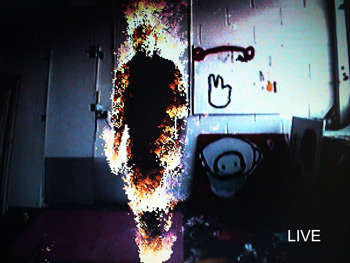About CyberSundays
CyberSundays is a new series of informal monthly Cybersalon discussions based in Central London. The themes will alternate between digital art and net activism. They cater for about 50 people on a first come basis and will include short presentations and a discussion followed by a chill social space with DJs and VJs.
These sessions will let us feedback work recently completed or in progress, duscuss new uses of tactical media, disseminate information from media art festivals and interventions and respond to current events and invited guests who may be in town. CyberSundays are a way for us to interact more closely with our core audience and provide fulfilling discussions where participants can exchange ideas more freely.
Be part of CyberSundays
We welcome suggestions for speakers and DJs/VJs for these events. To make
suggestions or for further info contact: <cybersundays@cybersalon.org>
Cybersundays are put together by:
Niki Gomez: <niki@cybersalon.org>
Richard Barbrook: <richard@hrc.wmin.ac.uk>
Monica Biagioli: <biagioli@freeuk.com>
Lewis Sykes: <lewis@cybersalon.org>
DIGITAL ART AND NET ACTIVISM # 2
About the Speakers
Dave Green on 'open source's journey through
computer software and potentially other media'.

Dave Green was first sighted on the internet in 1991, posting to alt.folklore.urban
about Peanut M&Ms. His apparent expertise was swiftly seized upon
by media outlets as varied as the BBC and the ill-fated UK version of
Wired Magazine, where he spent most of the '90s mocking the dotcom boom
and its inevitable catastrophes. He has been involved in a number of online
campaigns, from opposing the European Copyright Directive <ukcdr.org>
to monitoring new snack products <www.snackspot.org>,
and - for the last 6 years - has co-edited the UK's most sarcastic technology
newsletter, Need To Know <www.ntk.net>.
His catchphrases include "Ghosts cannot harm me" and "Oooh!
That Bill Gates".
Andrew Shoben on 'Greyworld: yesterday
and tomorrow'
Greyworld have made some of the world's most innovative public art in
the last ten years, their installations being enjoyed in 12 countries.
Andrew Shoben, the founder, will talk about their past pieces, and what
the future holds in store. <www.greyworld.org>

Greyworld was founded in Paris in 1993 by Andrew Shoben. Moving to London in 1995, their goal is to create works which articulate public spaces, allowing some form of self expression in areas of the city that people see every day but normally exclude and ignore. Greyworld have exhibited their work around the world, with permanent installations in twelve countries. This year, they will be unveiling several new installations in Liverpool, New York and Chicago.
In January 2002, Greyworld created the highly acclaimed ColourStops (1,2)
installation, a permanent work for five bus stops in Bradford, UK. For
this, they won a prestigious award from the Royal Society of Arts. Recent
works include Stairway (Hayward Gallery, 1999) Bench 2 (Nurture and Desire,
2000) Elektra (Norwegian National monument, 2000) Bridge 2 (Eire, 2001)
GreyTV (New York, 2001) and Sound Awards (Barcelona and Cape town, 2002)
They are currently working on a major new work for the Seager Distillery,
Deptford, entitled Streetdots.
Andrew Shoben lectures at the Royal College of Art, and is a visiting Professor to several Universities in the UK and the US. Since 1999, he has been a special advisor to the Arts Council of England (LAB) and has recently been nominated for a NESTA fellowship.
"In many ways Greyworld represents the shape of things to come.
The hybrid mix of artist, designer, urban planner and musician, producing
works that create spaces for play, fun and contemplation à making manifest
things which previously might only have been allowed space in the far
corners of our imaginations."
Clive Gilman, Fact Centre, Liverpool
"Greyworld have made some of the most innovative digital public
art of the last 5 years."
Matt Locke, Head of Imagineering, BBC
"...although the body is clearly present in virtual interaction,
since the body is the device through which we interface with the technology,
for instance by means of touch, sight and sound. For example, the group
of artists Greyworld create public art installations using generative
systems. Generative art is the capacity to programme a computer to 'generate,'
in the sense of 'setting in motion,'its own drawing or sound. In the case
of Greyworld's installations, the invisible application of technology,
underneath floors or hidden in handrails, is still predicated upon a physical
presence in the sense that each bodily encounter generates a different
creative output."
Pam Meecham, Understanding Modern Art Routledge
1999